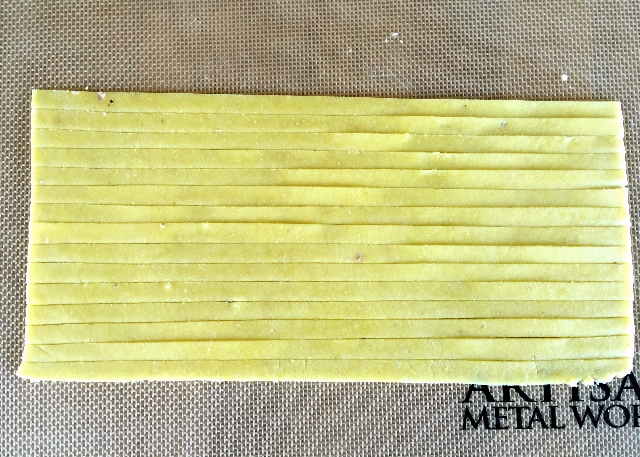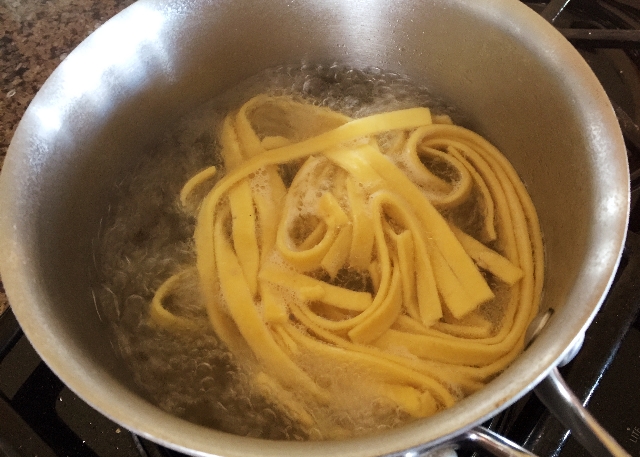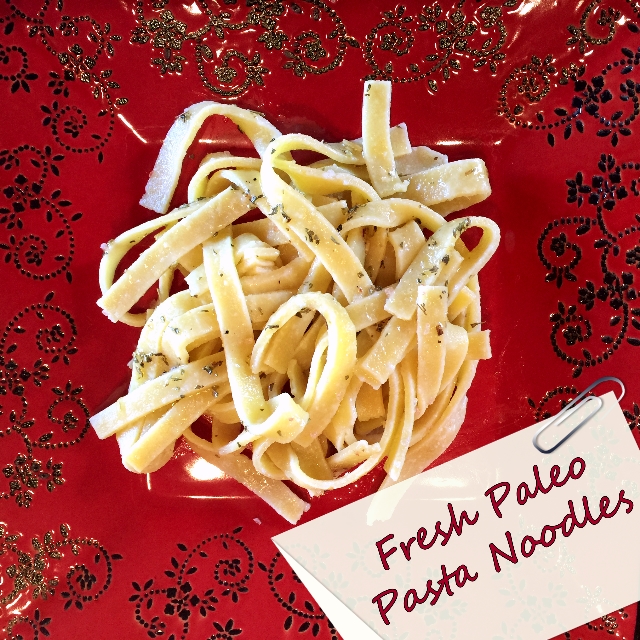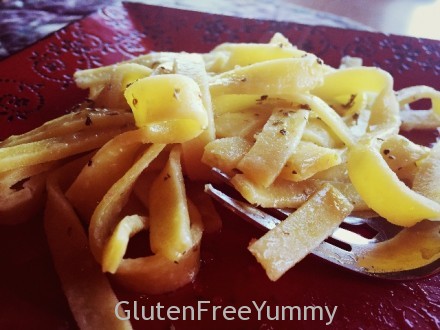Have you ever wanted to make your own grain-free pasta? In many ways it sounds like an oxymoron. Pasta has always been flour, eggs, and olive oil, so to make pasta without flour, even gluten-free flour, it seems impossible. I have a grain-free pasta recipe for you that proves it is anything but impossible! When I visited Italy with my husband back in October I felt a bit deprived when dining at the local restaurants; similar to how I felt years ago when there were minuscule gluten-free products on the market. When you tell an Italian restaurant owner that you are allergic to his pasta he just looks at you like you’re crazy, then offers you a plate of meat & cheese or a buffalo mozzarella salad. I ate a lot of both. Don’t get me wrong, I would eat all the mozzarella salads in the world to see the beauty of Venice again, okay maybe not all, but I wouldn’t miss seeing Italy just because I couldn’t eat their pasta.


As I walked along the streets of Venice staring into the Italian storekeeper’s windows, I came across a small bakery where the bread looked slightly different from other bakeries I had seen. Could this possibly be a gluten-free bakery? I took my card out of my pocket that told of my gluten allergy in Italian and showed it to the storekeeper. She read it and then started waving her hands wildly and shaking her head NO! There was a customer in her shop who spoke English and asked to see my card. She then said, ‘Go out this door, go over the first bridge, go down the alley and go over the bridge to the right. Then go down the next alleyway and over one more bridge then on your left you will find the store for your problem.’ Ha ha, I had to laugh. I never really thought of my allergy as a ‘problem’ but then again, I was in Italy and I guess one could say it is a problem finding anything to eat when all they serve is pizza and pasta on every street corner. We tried to follow her directions, but if you have ever been to Venice you know how every bridge and every alleyway start looking the same. We never did find the little gluten-free bakery, so once again I ate mozzarella, tomatoes, and basil.

I have never made homemade gluten-free pasta but today I tried my hand at it and I must say, it is really delicious. The trick is getting it thin enough, so if you have a pasta machine or a pasta attachment to your Kitchen-Aid, you will be much better off. I rolled my grain-free pasta free-hand, which is how many of the chefs prepare it in Italy, but it’s a little tricky getting it rolled even and thin.

I decided on a grain-free linguine noodle made with almond flour, arrowroot, tapioca starch and eggs. Because the pasta is fresh it only needs to cook for about 3-4 minutes.

It may not be quite as good as the Italian’s pasta, but for this gluten-free gal it comes pretty close! I tossed my fresh grain-free pasta in a little butter, Italian seasoning, and fresh Parmesan cheese but you could easily add your favorite pasta sauce on top. Enjoy!
PS: I love hearing from my readers, so please comment below if you like. I don’t mind suggestions for future recipes either. If there is something you’d like to see or a recipe you would like me to make, just post some suggestions.

Grain-free Pasta Directions:
Grain-free Pasta
| Serves | 4 |
| Prep time | 20 minutes |
| Cook time | 3 minutes |
| Total time | 23 minutes |
| Allergy | Egg, Tree Nuts |
| Dietary | Dairy-free, Gluten-free, Paleo |
| Meal type | Main Dish |
Ingredients
- 1 cup Almond Flour (extra-fine)
- 1 cup Tapioca Starch
- 1 cup Arrowroot Flour (2/3 for noodles, 1/3 for rolling dough)
- 2 Large Eggs (cage-free)
- 4 Large Egg Yokes (cage-free)
- 2 teaspoons Sea Salt
- 2 tablespoons Olive Oil (for cooking pasta)
Note
If you do not have arrowroot flour, substitute tapioca starch in its place.
Directions
| Step 1 | |
| Place a medium saucepan full of water on the stove. Add the olive oil (to prevent pasta from sticking) and bring to a boil. | |
| Step 2 | |
| Place all dry ingredients (only 2/3 cup of arrowroot) in a large bowl and stir about 2 minutes by hand to fully blend all the dry ingredients. | |
| Step 3 | |
| Make a crater in the center of the flour mix and add the eggs and egg yokes to the center. Whisk the eggs and slowly start pulling in the dry ingredients from the sides. Only partially combine the eggs and dry ingredients. | |
| Step 4 | |
| Sprinkle the remaining 1/3 cup of arrowroot flour on a cutting board. Add pasta mixture and begin kneading the dough. Knead the dough for about 4 minutes or until it is smooth. If your dough is too sticky add a little more almond flour. If your dough is too dry add a teaspoon of olive oil or water at a time until proper consistency is met. Divide the dough into 4 equal parts. Cover the remaining dough with plastic wrap while working with one section, so it won't dry out. | |
| Step 5 | |
| If you have a pasta machine or pasta attachment, run the dough through once on a zero setting then cut the pasta on a linguini setting. If rolling by hand, roll out dough with a rolling pin until desired thickness about 1/8 to 1/16" thickness. cut individual strips with a pizza cutter. | |
| Step 6 | |
| Drop noodles into boiling water and cook for about 3-4 minutes. Strain noodles and place desired topping on hot noodles. Serve immediately. | |

 Print recipe
Print recipe

these pictures are amazing! i’m not allergic to gluten, but i still like to eat GF as often as i can, i will so try this!
Thank you! It’s hard to take a bad picture in Venice!
Looks delicious!! I can’t wait to try it!
I hope you get a chance to try them, Candi. They were very tasty.
This looks amazing! I have been having a huge pregnancy craving for pasta lately. Yummm!!
My mom said she craved buttered noodles her whole pregnancy with me. I told her that’s why I have a gluten allergy; she over-dosed me in the womb! Haha.
Wow, those picture of Venice are beautiful! I can’t wait to go there someday. When I first was reading this I thought that seemed way too complicated, but reading your directions it doesn’t seem all that bad. Thank you for the recipe!
I’ve shy’d away from homemade pasta for years because I thought it would be complicated too! I was very surprised at how easy it was.
This looks absolutely delish! Your pictures are stunning – it makes me miss Italy! I have never made homemade pasta before, but you make it look easy!
xo katie // a touch of teal
It not only looks easy to make, it really is! I hope you get a chance to try it sometime, Katie.
Thanks for sharing this. I’m not gluten-free but many of my friends are so I like getting recipes to try out for them so we could actually have dinners together.
You are welcome! And my recipes are a cup for cup substitute, so if you want to use regular flour in place of the gluten-free flour for just you, you can!
Any lower carb options than arrowroot or tapioca?
Hi Amelia,
You can try using 100% almond flour in the place of the tapioca & arrowroot, but I personally have not tried this, so I’m not quite sure how the texture & rolling ability will be. I have been toying with creating a low carb ravioli using only almond meal & eggs, so hopefully look for that in the next few weeks.
Would it be possible to swap out the almond flour for another form of nut flour?
just curious as I have finely ground hazelnut meal in my cupboard and it would save me a trip to the grocer.
I believe Hazelnut could be substituted with no problem. Let me know how it turns out!
So, have you used these for chicken and noodles? That is my #1 comfort food but being diabetic, I also must have low-carb as well as GF. Looking for a good noodle that won’t fall apart in the broth.
Hi Joy, I have only used them as buttered noodles. I did have a recent subscriber say they fell apart in the water. I personally have never had that happen, but I am going to try the recipe again and see how it turns out. I would recommend trying the miracle noodle. It is extreme low carb and fantastic for diabetics. http://www.miraclenoodle.com
Dear Laurie, wondering if you’d ever tried making pasta with green banana flour. Not a problem about carbs,and maybe nut flours don’t suit a lot of people. I’ve been reading articles about scientists in Argentina and Italy doing experiments and have managed to make a pasta that is almost identical to wheat pasta. Uses eggs and I think gum of some kind for elasticity. Can’t find a recipe though. Have you any thoughts?
Regards, Sandy
Hi Sandy,
Thank you for this information. I will check into it. I have never used green banana flour, but this intrigues me! I’ll let you know what I find. I did see that in two cups of banana green flour there are almost 2000 calories and 416 carbs, YIKES! I guess it could be a once in a while splurge!
so if I only have tapioca flour/starch, I should use 2 cups? or is it either tapioca or arrowroot?
You can substitute Tapioca in it’s place, but remember, it will be 1 2/3 cup for the noodles and 1/3 cup for rolling the dough. I do think the recipe works slightly better with tapioca starch & arrowroot combined.
What’s the difference between tapioca & arrow? Thx 🙂
Hi Francilia, arrowroot and tapioca are both starches and can be used in recipes to substitute where other starches may be used, such as corn starch. One of the main differences is that tapioca starch can withstand higher heat. If you are planning to freeze something, arrowroot tends to be better, because products containing tapioca that have been frozen and thawed tend to separate. In gluten-free baking, neither one can stand alone; they must be mixed with other gluten-free flours to ensure success.
Thanks so much for this recipe! How does this hold together? Does it break easily?
Hi Heather,
Mine held together fairly well. It was a little tricky moving it from the cutting board to the boiling water. I did have one comment from someone who tried it and wrote in that it fell apart in the water. This has not been my experience, so play with your dough a bit and make sure you have a firm consistency to work with.
Thinking of buying a pasta machine, can I use your recipe in the machine?
Hi Ina,
I have not tried it in a pasta machine. I’m not exactly sure how it would perform due to the fact there is no gluten to bind it all together. If you try it and it works, I would love to know.
I am so going to try making this gf pasta.
Thank you!
Let me know how it works for you. It can be a little temperamental!
I made an almond flour pasta dough recipe but it broke into tiny pieces when i rolled it through the machine. I cooked it immediately and it tsted good but i miss the long strands. Any suggestions
I haven’t had luck through a pasta machine either. I hand rolled mine and cut it with a knife. The gluten in regular flour adds binding and elasticity. Without gluten it is difficult to work with but not impossible.